
A polearm or pole weapon is a close combat weapon in which the main fighting part of the weapon is fitted to the end of a long shaft, typically of wood, extending the user's effective range and striking power. Polearms are predominantly melee weapons, with a subclass of spear-like designs fit for thrusting and/or throwing. Because many polearms were adapted from agricultural implements or other fairly abundant tools, and contained relatively little metal, they were cheap to make and readily available. When belligerents in warfare had a poorer class who could not pay for dedicated military weapons, they would often appropriate tools as cheap weapons. The cost of training was comparatively low, since these conscripted farmers had spent most of their lives using these "weapons" in the fields. This made polearms the favoured weapon of peasant levies and peasant rebellions the world over.
A spear is a polearm consisting of a shaft, usually of wood, with a pointed head. The head may be simply the sharpened end of the shaft itself, as is the case with fire hardened spears, or it may be made of a more durable material fastened to the shaft, such as bone, flint, obsidian, copper, bronze, iron, or steel. The most common design for hunting and/or warfare, since ancient times has incorporated a metal spearhead shaped like a triangle, diamond, or leaf. The heads of fishing spears usually feature multiple sharp points, with or without barbs.
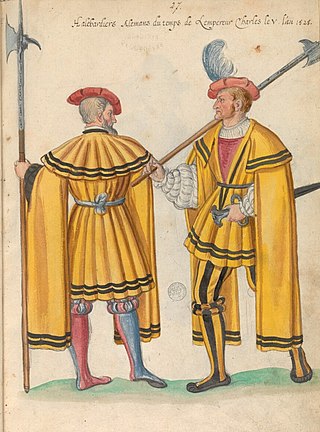
A halberd is a two-handed polearm that came to prominent use from the 13th to 16th centuries. The halberd consists of an axe blade topped with a spike mounted on a long shaft. It can have a hook or thorn on the back side of the axe blade for grappling mounted combatants. The halberd was usually 1.5 to 1.8 metres long.

In cutlery or kitchenware, a fork is a utensil, now usually made of metal, whose long handle terminates in a head that branches into several narrow and often slightly curved tines with which one can spear foods either to hold them to cut with a knife or to lift them to the mouth.

A trident is a three-pronged spear. It is used for spear fishing and historically as a polearm.
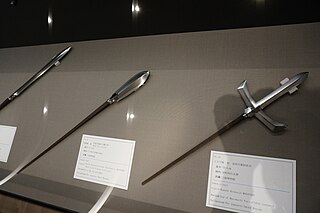
Yari (槍) is the term for a traditionally-made Japanese blade in the form of a spear, or more specifically, the straight-headed spear. The martial art of wielding the yari is called sōjutsu.

A pitchfork or hay fork is an agricultural tool used to pitch loose material, such as hay, straw, manure, or leaves. It has a long handle and usually two to five thin tines designed to efficiently move such materials.

A glaive, sometimes spelled as glave, is a type of pole weapon with historical origins in Europe, known for its distinctive design and versatile combat applications. It is similar to other polearms such as the war scythe, the Japanese naginata, the Chinese guandao, the Korean woldo, and the Russian sovnya.
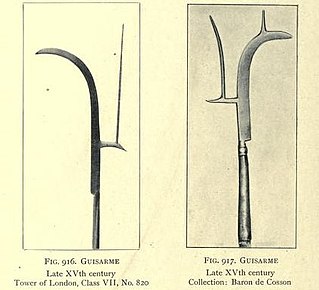
A guisarme is a polearm used in Europe primarily between 1000 and 1400. Its origin is likely Germanic, from the Old High German getīsarn, literally "weeding iron". Like many medieval polearms, the exact early form of the weapon is hard to define from literary references, and the identification of surviving weapons can be speculative.

A fauchard is a type of polearm which was used in Europe from the 11th through the 17th centuries. In later use fauchards became ornamental and ceremonial, growing in size until some examples were almost too heavy to carry, let alone use. The design consisted of a curved blade atop a long pole, although in some portrayals, it is shown on a shorter pole. The blade bore a moderate to strong curve along its length. The cutting edge was only on the convex side of the blade, unlike the guisarme or bill. The fauchard was likely developed from the war scythe with the cutting edge turned opposite, convex instead of concave, so that the weapon was good for both thrusting and slashing attacks.

The Lucerne hammer is a type of polearm which was popular in Swiss armies during the 15th to 17th centuries. It was a combination of the bec de corbin and a pronged war hammer.

A spetum is a polearm that was used in Europe during the 13th century. Other names include chauve souris, corseca, corsèsque, korseke, runka, and rawcon. It consists of a pole, some 6–8 ft (1.8–2.4 m) long, on which is mounted a spear head with two projections at its base. Many variations of this design flourished over time; some feel that the ranseur is a variation of the spetum. According to antiquarian John Hewitt, the spetum is a variation of the partisan. The spetum is usually distinguished from the ranseur and partisan by its "prongs" being single edged and used for slashing. The main blade is 12–14 in (30–36 cm) long, and the side blades are only about half that length and are set at acute angles.
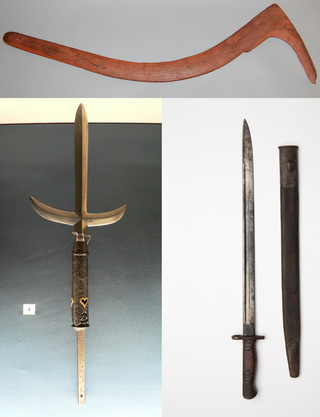
A melee weapon, hand weapon, close combat weapon or fist-load weapon is any handheld weapon used in hand-to-hand combat, i.e. for use within the direct physical reach of the weapon itself, essentially functioning as an additional extension of the user's limbs. By contrast, a ranged weapon is any other weapon capable of engaging targets at a distance beyond immediate physical contact.

The dagger-axe is a type of polearm that was in use from the Longshan culture until the Han dynasty in China. It consists of a dagger-shaped blade, mounted by its tang to a perpendicular wooden shaft. The earliest dagger-axe blades were made of stone. Later versions used bronze. Jade versions were also made for ceremonial use. There is a variant type with a divided two-part head, consisting of the usual straight blade and a scythe-like blade.
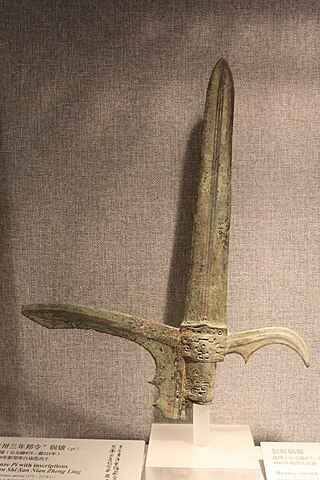
The ji was a Chinese polearm, sometimes translated into English as spear or halberd, though they are fundamentally different weapons. They were used in one form or another for over 3000 years, from at least as early as the Zhou dynasty, until the end of the Qing dynasty. They are still used for training purposes in many Chinese martial arts.

Tines, prongs or teeth are parallel or branching spikes forming parts of a tool or natural object. They are used to spear, hook, move or otherwise act on other objects. They may be made of wood, bone, metal, or similar materials.

A war scythe or military scythe is a form of pole weapon with a curving single-edged blade with the cutting edge on the concave side of the blade. Its blade bears a superficial resemblance to that of an agricultural scythe from which it is likely to have evolved, but the war scythe is otherwise unrelated to agricultural tools and is a purpose-built infantry melee weapon. The blade of a war scythe has regularly proportioned flats, a thickness comparable to that of a spear or sword blade, and slightly curves along its edge as it tapers to its point. This is different from farming scythes, which have very thin and irregularly curved blades, specialised for mowing grass and wheat only, unsuitable as blades for improvised spears or polearms.

The sasumata is a polearm used by the samurai class and their retainers in feudal Japan.
The Muyesinbo is a Korean martial arts manual published in 1759. The book is a revision of the older Muyejebo, made during the reign of King Youngjo (1724–1776). It adds twelve disciplines or "skills" of both armed and unarmed fighting by Prince Sado to the original six which were descbribed in the Muyejebo. No copies of the Muyesinbo have survived, but its contents can easily be determined by tracing back and comparing the Muyejebo with the later Muyedobotongji.

The three most common types of Chinese polearms are the ge (戈), qiang (槍), and ji (戟). They are translated into English as dagger-axe, spear, and halberd. Dagger-axes were originally a short slashing weapon with a 0.9–1.8 m long shaft, but around the 4th century BC a spearhead was added to the blade, and it became a halberd. The spear is also sometimes called a mao (矛), which is sometimes used to designate polearms with a wavy snake-like spearhead. There was another polearm weapon known as the pi (鈹), translated into English as either sword-staff or long lance, that was used from ancient times until the Han dynasty. It was essentially a short sword attached to a stick. From the Warring States period onward, the length of Chinese polearms varied from around 2.8 to 5.5 m ; however, there is no specific designation for a pike in the traditional Chinese lexicon. A very long spear is just called a long spear.


















